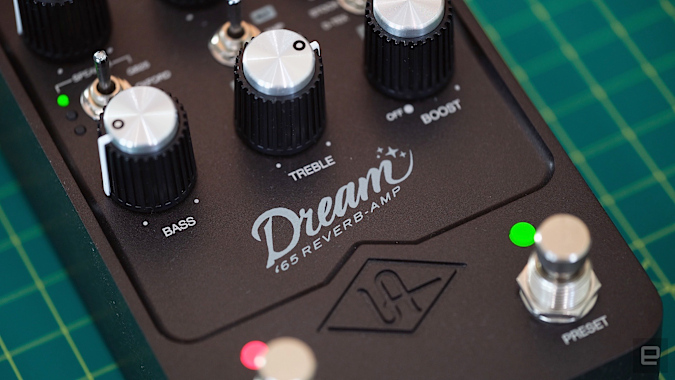Image Credit: Terrence O’Brien / Engadget
While the onboard controls are easy enough to wrap your head around, the UAFX app makes things even easier. You can’t control every parameter using the desktop or mobile apps, but you can change presets, tag your favorites and customize the function of the two footswitches. Out of the box the left footswitch turns the pedal on and off, while the right switches between your last preset and live controls. But that’s probably not the most useful configuration. Chances are you’re just going to leave the amp sim on all the time. So using one switch to engage the boost or turn on the vibrato makes more sense.
The app also comes loaded with presets that make dialing in excellent tones a cinch. There are over a dozen factory settings, plus artist presets from people like Nels Cline of Wilco, Jessica Dobson of Deep Sea Diver, Jim James of My Morning Jacket, and Cory Wong of Vulfpeck.
Image Credit: Terrence O’Brien / Engadget
The one thing to note here is that you can only update the pedals’ firmware using the desktop app over USB. Which is probably for the better, since I’ve found that the Bluetooth connection to the mobile app can be a bit unstable. A recent firmware update improved the situation, but it still drops every so often.
The last thing to mention before we move on to the sounds is the build quality. The UAFX modelers are just absolute bricks. While any stompbox worth its salt is going to be pretty rugged and made out of metal (they have to survive being repeatedly stepped on, after all), these are in a class of their own. They’re quite a bit heavier than your average pedal, are cast from extremely dense aluminum and would definitely cause some serious damage if dropped on an exposed toe – barefoot players beware.
Terrence O’Brien / Engadget
Alright, so we’ve established that they’re well built, feature excellent connectivity options (all three are stereo as well) and sound great, but what is it about the sound that sets them apart from the rest of the amp modelers out there? Well, the short answer is, the feel.
I know, that’s a bit nebulous, but there’s something about the way these pedals respond to your playing that feels more natural and authentic than many modelers, even those based on impulse responses (IRs). An IR can get you a great sounding amp or cab sim, but because they’re based on audio files, they tend to be less dynamic than the real deal. The UAFX pedals clean up considerably if you turn down the volume on your guitar, or play very delicately. And they creep into break up as you start playing harder.
They also take effect pedals incredibly well, which isn’t something you can assume in my experience, especially when it comes to dirt. My Fuck Overdrive and Part Garden fuzz pedals posed no challenge, and honestly the overdrive probably sounded better though the UAFX modelers than it does through my Blues Jr.
This demo features a few sounds from the Ruby ’63 Top Boost Amplifier with only slight EQing done in post. The last portion of the clip adds a delay pedal to the mix.
This is where we have to stop lumping the three pedals together, though, because they all sound incredibly different from each other. No one is better than the other, but your personal preference will dictate which is the best choice for you. Do you want crisp clean tones that you can pair with iconic spring reverb and vibrato? The Dream ‘65 is the ticket. Need super bright chimy sounds that be pushed into classic blues-rock crunch? Then it’s the Ruby you’re looking for. And if you want darker, dirtier sounds, go for the Woodrow.
Personally, I’m into the Dream. Its cleans are pristine and glorious. And when paired with the built-in spring reverb emulation it becomes a perfect machine for surf rock or more ambient styles where your pedalboard is doing a lot of the heavy lifting. It’s also an excellent vehicle for funk and soul where you want something sharp that will cut through the mix without stealing the spotlight.

Terrence O’Brien / Engadget
Even though I have a board full of fancy reverbs and a tremolo pedal I’m head-over-heels for, I actually still found myself turning to the built-in versions of the Dream pretty frequently. The spring reverb here is as close to the real thing as you’re gonna get. It drips and rattles just like the spring in my Blues Jr and I don’t think I could pick it out as a digital effect in a blind taste test. The vibrato (which, again, is actually tremolo) is equally great. It has a warm vintage feel that is closer to the tube-power vibrato of yore, than my new-school tremolo.
I also think that the three different boost channel options and six different cab simulations give you the most tonal versatility of the three pedals. Pairing the stock boost with the GB25 cab delivers excellent clean tones even at higher volumes. But flip to the lead mod and go with the EV12 cab and you can rip a pretty searing solo.
The pedal even starts to break up a bit if you hit it with too hot of a signal. But it doesn’t clip the way that, say, a digital audio interface would. Instead, it kind of crackles just like a real amp might. It’s these nice little touches that make the UAFX pedals so convincing.
Image Credit: Terrence O’Brien / Engadget
The Woodrow goes in the opposite direction of the Dream. While you can certainly get clean tones from it, it excels at riff-rock crunch and arena-filling distortion. You can even push it into full on fuzz territory without the aid of pedals. With my humbucker-equipped Fender Toronado tuned down to C standard it was the perfect partner for knocking out Queens of the Stone Age songs.
Overall, it has a darker, edgier tone that can almost reach sludge metal territory. It even works well with bass, which is handy if you want to have a single amp modeling pedal for everything. I used it to track a few bass parts on some demos and it sounded way better than any dedicated bass amp VST I’ve tried (which is admittedly very few).
This demo features a few sounds from the Woodrow ’55 Instrument Amplifier with only slight EQing done in post. The last portion of the clip adds a fuzz pedal to the mix.
The Woodrow has few tricks up its sleeve too. One is that, like the Fender Tweed amps it’s emulating, it has two channels: instrument and mic. They have slightly different characters and you can blend the two together here allowing you to take advantage of both the cleaner, but warmer, mic channel, and the brighter, dirtier instrument one simultaneously. There’s also a dedicated knob on the front for dialing in room tone, allowing you to recreate the ambience of a miked amp in a studio.
The Ruby also has a room emulation, and I will say it’s one of the few things I think UA could improve on a bit. At lower settings – say, with the dial below nine o’clock – the effect is reasonably subtle and can make recording directly through your audio interface sound a little more alive. Anything beyond that, though – a full 75-percent of the range – is just too much for my tastes. At the extreme high end It makes your guitar sound like it’s being played at the other end of a 100-yard stretch of sewer pipe. I’m sure there are some artistic applications for it, but I can’t imagine there are many.
This demo features a few sounds from the Dream ’65 Reverb Amplifier with only slight EQing done in post. The last portion of the clip adds a reverb pedal to the mix.
If you just ignore the room tone thing, the Ruby is another winner. It might cover the widest range of tones of the three, though I’ll admit finding it the hardest one to dial in the way I like. (But once I did, it contained some of my favorite sounds.) As you’d expect from an AC30 emulator the Ruby handles the bright chimes of REM and U2 with ease, but when cranked gets the creamy sustain you associate with Queen. Plus, it’s basically the quintessential British Invasion amp.
You can easily push further into full on distortion too since it incorporates two popular boost options on the channel switch, and also changes between two different revisions of the amp. Normal mode is a 1961 AC30, which lacked the top boost circuit, paired with an emulation of the Dallas Rangemaster treble booster. Dialed in right you can get the thick sounds of Black Sabbath here. The Bril and Vib options are based on the 1963 top-boosted AC30, which is really what you want if you’re going for that classic bright cutting tone.

